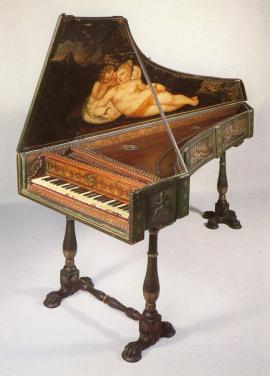Italian harpsichord

Single-manual harpsichord by Alessandro Trasuntino, Venice 1531; London, Royal College of Music Museum of Instruments.
This is a harpsichord with a separate outer case, where wooden strips additionally reinforced the side walls to prevent the risk of breakage. Although the elaborate painting is generally typical for harpsichords of this time, it is rather rare for Italian instruments.
Music example:
Excerpt from Giovanni di Macque: Two Galliards
played by Gustav Leonhardt
Instrument: Harpsichord by Carlo Grimaldi, Messina 1692
Italian harpsichords exhibited some individualistic features that made them distinctive: the soundboard and case were usually made of cypress wood and were so light that even a grand wing-shaped instrument could be carried by one person. On the other hand, the walls were so thin that the instrument required a case for storage, as any external bump could cause significant damage. For playing, the instrument was typically removed from the case and placed on a table. After about 1610, more stable instruments were also made, which were firmly attached to their cases.
Typically, an Italian harpsichord had only one keyboard and two or even just one rank, which contributed to the lightness of these instruments. However, this construction provided a strong yet transparent, though somewhat short, sound that blended excellently with a single voice while still being discernible among several instruments. This made it ideal for use as a general continuo instrument, on which the harmonized bass line was played. Thus, the harpsichord grew into the role of the ensemble leader's instrument in secular music during the 16th and 17th centuries (in churches, the organ mostly fulfilled this function). However, Italian harpsichords are far less suitable for solo playing than the longer-resonating instruments north of the Alps, and consequently, solo literature played a diminishing role in Italy from about the mid-17th century.
The unique construction and special string scales made Italian harpsichords exceptionally durable—many instruments in museums remarkably show no cracks or warps due to construction-related excessive string tension even after centuries, unlike the seemingly more stable Flemish instruments, for example. They were also exported to many countries and are therefore still widely found today.
Strangely, the later developments in harpsichord construction in Flanders or France did not influence Italian instruments; thus, Italian harpsichords remained almost unchanged for many centuries until they were sidelined by an invention by a brilliant Italian harpsichord maker that was barely acknowledged in Italy: the "Gravicembalo col piano e forte" by Bartolomeo Cristofori.



